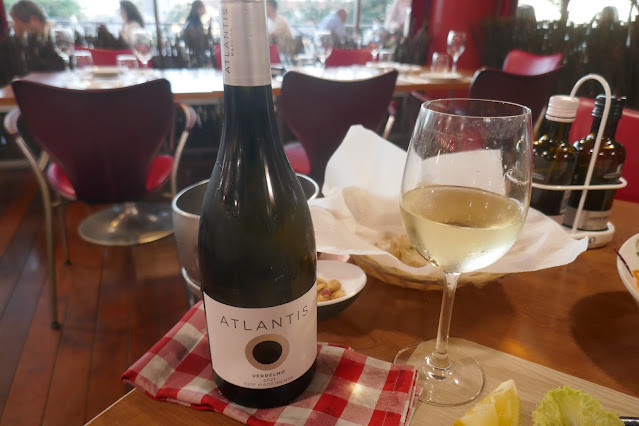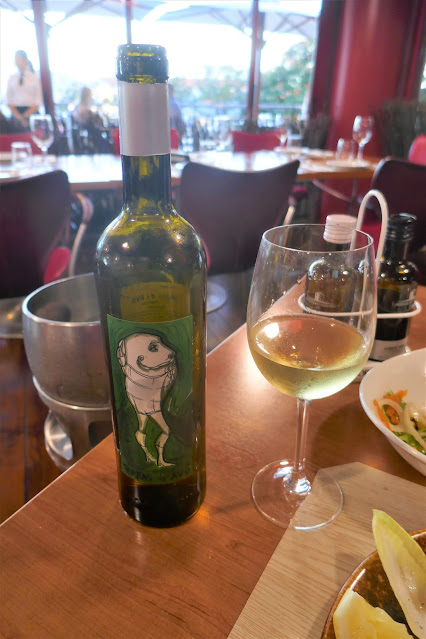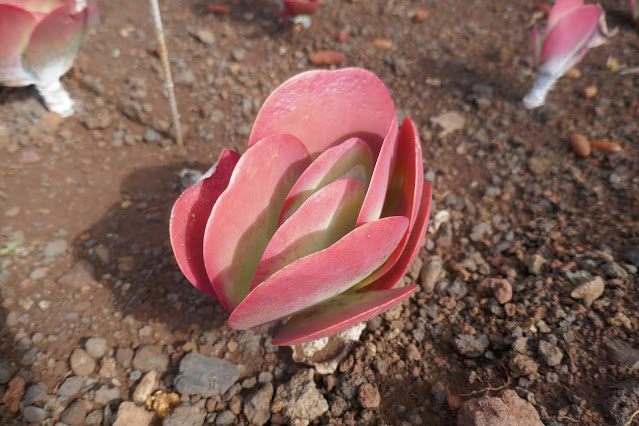Slogging up Through the Foothills
17-Apr-2023 to 23-Apr-2023
The Mission
 |
| Portugal |
 |
| Madeira |
Breakfast
Our hotel’s breakfast buffet, was a magnificent spread covering the morning eccentricities of every corner of Europe. There was
nothing Chinese, Indian (see Breakfast
Thoughts in Udaipur ) or American, but they know their clientele.
As far as I can ascertain a local breakfast consists of coffee and bread or toast with whatever you wish to spread on it; in south west Europe breakfast is not the meal by which to judge the local cuisine.
Madeira is, of course, geologically Africa, but the people are Portuguese and so
is their breakfast.
Lunch
We ate light lunches – a toastie
or a sandwich - washed down with beer, except the day we could face no more
food, so just had beer.
Madeira has a craft
brewery or two, but they require seeking out. Coral beer, on the other hand, is sold
in every café on the island. Produced by the Madeira Brewing Company, who have
been active since 1872, it is a standard southern European pilsner-style lager.
It is nothing special, but deals excellently with a thirst on a warm day.
On draught it comes in glasses of 20 (why bother?), 30 40 or 50cl. Sometimes, though, for a real thirst, you need something bigger.
 |
| Sometimes you need a big bottle of beer |
Many cafés offer a dose de camarão fritas or a dose de lapas grelhadas. ‘Dose’ means ‘portion’ – we use the same word in English with a different shade of meaning (cod and chips twice and a
dose of mushy peas, anyone?). Camarão fritas are fried prawns, lapas grelhadas
are the more edgy grilled limpets (you don't get those in the Algarve). My friend Brian had visited these shores
before and warned me – ‘they have two parts,’ he said, one is a big muscle to grip
the rocks, the other contains its bowels and anus. One part you can’t eat, the
other you don’t want to eat.’ These may not be his precise words, but I believe I have the gist.
Despite the warning, and
my respect for Brian’s opinions, we ordered a dose between us.
 |
| A dose of limpets, Café Teatro, Funchal |
I had imagined Brian was talking about the large conical limpets I used to try to knock off the rocks in my youth during holidays on the South Wales coast (you had to make your own fun in those days), but these were flatter. The muscle in a Porthcawl limpet is truly mighty, eating it would be like chewing a squash ball, but these were…um…all right. Lynne enjoyed them so much she had another dose a few days later and I thought they were best shellfish I have ever
eaten, except for all the others.
Bolo do Caco is the usual accompaniment to limpets, and very many other things. It is a flatbread the shape of a cake (bolo) cooked on a basalt slab (caco). It is usually served split with the interior slathered with garlic butter.
A Pre-dinner Drink
Unlike mainland Portugal, Madeira’s climate is suitable for growing sugar cane and aguardente de cana is made by distilling
fermented cane juice. Mixing it with orange and/or lemon juice and sweetening
it with sugar or honey produces Madeira’s traditional drink, poncha.
Poncha resembles a daiquiri but has more fruit and more fire. Daiquiris are made with three-year-old Havana rum, a smooth, amiable sprit, while
Poncha involves a 50% alcohol Madeiran white rum of unknown aging. Poncha can be
bought ready made in bottles, but most restaurants make their own, a couple of
jugs are usually parked in sight of the diners and given a stir by any passing
waiter.
 |
| A glass of poncha while studying the menu |
Poncha has a pleasant balance of alcohol, sweetness and acidity and at 25% alcohol is an ideal pre-dinner drink.
Dinners
We were in Madeira for seven nights, that is zero starters, seven main courses each and a few desserts; a single course meal is often
enough for us these days. With a possibility of 14 mains, we thought we
could at least scratch the surface of Madeiran cuisine. We ate in mid-range restaurants in the Lido district of Funchal, where we found average price for a one or two course meal was a little over €70, including an aperitif and bottle of wine.
Fish and Sea Food Mains
Geography dictates that fish will be important, some dishes will be shared with mainland Portugal, and others will be typically
local. The most typically local of all is the Black Scabbardfish.
 |
| Black Scabbardfish, Funchal Market, Madeira |
Black Scabbardfish We have frequently encountered silver scabbardfish in Algarve markets, but
never on a menu - which might say something about them - but the Black Scabbardfish
was new to us. They look similar (apart from the colour) and are both members
of the family Trichiuridae, but the black scabbard prefers the deeper water
around Madeira and appears on every Madeiran menu. With its thin pointy face
and evil looking mouth filled with long sharp teeth, this is the ugliest fish in
the world according to the locals, though for down to earth plug-ugliness nothing
compares to the Monk fish.
 |
| Silver Scabbardfish, Olhão Market, Algarve |
My fillet lounged on cushion of potato purée with a banana where its spine would have been had it not been filleted. Madeiran bananas
are shorter and sweeter than the Cavendish bananas from the Caribbean and Central America that we are used to. Over this are the juice, seeds and flesh
of a passion fruit. Madeira is not technically a tropical island, but it
produces a lot of tropical fruit.
Fruit and fish are tricky plate-fellows, but this combination works, the sweetness of the banana and the acidity of the passion fruit perk up
the scabbardfish, which, dare I suggest, owes much of is popularity to its
availability.
 |
| Black Scabbardfish with banana and passion fruit - it looks alarming but tastes delicious Unnamed restaurant at the top of Rua do Gorgulho |
Tuna with Maize. Tuna is equally popular in the Algarve but on Madeira fried maize (I think we
would normally call it polenta) is the traditional accompaniment. Tuna is inevitably
described as ‘meaty’ and here the markings on the flesh were almost the only
clue it was not meat; and the accompanying sauce could be called gravy without giving
offence. Boiled potatoes with fish is an unwritten Portuguese rule and the
polenta sits beside the spuds in neat cuboids. Crisp outside, soft inside it
had little flavour, but justified its presence by providing two new textures.
 |
| Tuna with Polenta, Reaturante Tricolore, Estrada Monumental |
Wrasse. I have never seen
wrasse on a menu before and after looking it up I wonder if this was a mistranslation.
Unfortunately, I did not check the Portuguese menu at the time and this restaurant does not
have its menu on-line. Two large pieces of fish, simply presented
and perfectly cooked went down well.
 |
| Wrasse, Restaurante Tricolore, Estrada Monumental |
Salt Cod became a Portuguese
staple in the days before refrigeration and they still eat it, on Madeira as
well as the mainland. Lynne’s perfectly cooked slab of cod, hid beneath a pile
of caramelised onions.
 |
| Salt Cod, unnamed restaurant at the top of Rua do Gorgulho |
Squid is on every menu
and we both ate squid, though at different restaurants on different days. In the
Algarve the norm is one or two larger squid grilled or a multitude of small squid
given a different treatment. On both occasions here we had four or five smallish squid.
Occasionally the boiled potato rule is relaxed for squid and it is served with
rice.
 |
| Grilled squid and rice, Restaurante Tricolore, Estrada Monumental |
Octopus is common in the Algarve and almost always cooked à lagareiro. Nearby restaurants in Funchal
offered more variety, but my choice of Octopus Rice was not a great one. It was
cheaper than most main courses and very pleasant, but I would have liked more
octopus – you get what you pay for, the error was mine for choosing it.
 |
| Octopus rice, Mad Market Restaurant, Estrada Monumnetal |
Arroz de Marisco (Rice with seafood) is a particular favourite of mine. Traditionally a bowl for two is brought to the table and given a judicious stir by the waiter before ladling out the first portions. The seafood content can depend on what is available in the market that day but I suspect the differences from our expectations were because this is Madeira - though it might be the restaurant. The basic flavours were good and the bowl was near-inexhaustible as it should be, the seafood was plentiful and well-cooked but there was only squid, mussels and prawns. In the Algarve you also expect langoustine, a crab claw and maybe a leg or two as well. I also prefer seafood served in its shell (except for squid!) getting your hands messy, is all part of the fun. Well-made as it was, I found this a little disappointing.
 |
| Arroz de mariscos- nothing wrong with what's there, but what's missing lets it down Reaturante Tricolore, Estrada Monumental |
Meat Main Courses
Espedata is basically a
kebab - not to be confused with espada, (scabbard fish) and espadarte
(swordfish) as at least two of these three words appear on every menu. The traditional
food of a festa, of which Madeira has many, espedata is no
common-or-garden kebab. Large chunks of beef are rubbed in garlic, salt and bay
leaf and marinated for 4 to 6 hours in Madeira wine, red wine vinegar and olive
oil then skewered on a laurel stick and grilled over glowing wood chips.
 |
| Espedata, with our irascible host caught in his own mirror, Restaurante Tokos, Estrada Monumental |
We ate espedatas at a relatively expensive restaurant run by an elderly and mildly eccentric chef-patron. To our request for a poncha
he replied sharply, ‘No, poncha is a bar drink, this is a restaurant.’ That
told us – though he is out of step with every other restaurant on the island. We
had a glass of Madeira instead, medium dry Verdelho, the only Madeira (as
opposed to Vinho Madeirense – see below) we drank, other than ‘free’ samples.
He had grown the potatoes for the chips himself, he told us, and they were good, but his steak was the joint-best I have ever
eaten, equalling the slab of Welsh Black I enjoyed at the Abercrave (sic) Inn
in Abercrâf on the edge of the Brecon Beacons in 2007. Cooked rare as requested
it was richly flavoured, juicy and hit the perfect spot on the tender-to-tough
spectrum.
Carne de
Vinho e Alhos or as the English menus put it, 'Meat, Wine, Garlic', is another traditional festival dish.
The ‘meat’ is pork and this dish was traditionally eaten at the time of the annual
pig slaughter a few weeks before Christmas. The pork should be marinated for
three days in white wine, vinegar, salt, and pepper. Mine, unfortunately was
not good, the fat free meat was very dry. There were, though a few very welcome olives on the plate. A big difference between Madeira and the Algarve is the paucity of olives here; on the mainland olive munching is obligatory twice daily, at least.
 |
| A not so successful 'meat, wine, garlic', Unnamed restaurant lower down Rua do Gorgulho |
Lamb. Meanwhile at the other end of the table, Lynne’s lamb was fine, and no worse for being unassociated with any festival.
 |
| A very satisfactory lamb chop Unnamed restaurant lower down Rua do Gorgulho |
Desserts
Restaurants in Funchal do not apparently offer the same variety of bolos (cakes) and tartes as their Algarve counterparts. There is a pastry called mel de cana
(sugar cane honey) and a cake called bolo de mel which are made from
sugar cane without any bee input, but neither came our way. I had a Tricolore
Cake as a dessert which was good, though not great, and didn’t have three colours.
Pineapple. Madeira produces custard apples, passion fruit, papaya and other tropical fruits, but only pineapples seemed to appear on dessert menus. Pineapple
with Madeira wine after my scabbardfish was pleasant, but the irascible chef
took a slab of pineapple, flambéed it in Grand Marnier and popped some vanilla ice-cream
on top, and that was a joy. Everything he did was simple, but perfectly executed
using the finest ingredients, so I happily forgive his high prices.
 |
| Pineapple flambéed in Grand Marnier , Restuarante Tokos |
Pudim Flan (Caramel custard), is ubiquitous throughout Portugal. It slides down so easily, it is the perfect dessert if you are a bit
full, and sometimes it is just the perfect dessert. Rarely it can go wrong and
Lynne did have a poor one – milk is used to make them, but it should not taste
of milk – but she had another at a different and that was exactly as it should be.
 |
| Pudim flan, bordering on perfection, Restaurante Tricolore, Estrada Monumental |
Coffee
A Portuguese espresso is known as bica. Short, sharp but never bitter, it is a fine way to end a meal.
 |
| Bica |
Wines
DOP Madeira
DOP (Denominação de Origem Protegida) Madeira, for historical reasons usually just known as ‘Madeira’ was the wine used to toast the American Declaration of Independence. It is a fortified wine and apart from the one occasion noted above we did not drink Madeira in any restaurants. We did, though, visit two Madeira producers Blandys - see Funchal (1) and Barbeito in Câmara de Lobos and I delve into that story then
DOP Madeirense
Madeirense is the designation for the island's quality table wines. As most grape production goes for making Madeira,
Madeirense is produced in small quantities by about a dozen wineries, making it
relatively expensive. In restaurants a standard cuvée costs €22 - €26, about
double what you might pay for a similar quality wine on the mainland.
With our two meat meals we drank Alentejo reds, more
expensive in Madeira than on their home turf, but cheaper than Madeirense. The
Mad Market Restaurant could not offer a Madeirense at a price I was prepared to
pay, so we drank Alentejo branco. With our other four dinners we drank Madeirense.
 |
| DOP Madeirense. There is condensation of the glass, the wine was crystal clear |
Barbusano Verdelho. Quinta do Barbusano, at São Vicente on the north coast of the island, produces all its
white wine from the premium Verdelho grape. A mineral flavour with citrus
backbone, some find tropical fruits in it as well. A long, clean finish
 |
| Barbusano Verdelho |
Atlantis Verdelho. Atlantis is a brand of the Madeira Wine Company who own most major producers of
Madeira. Their Verdelho is a less accomplished and complex version than Barbusano’s, it tends
to be a little cheaper too.
 |
| Atlantis Verdelho |
Terrabona Arnsburger Terrabona is a Funchal winery, Arnsburger is a little-known Riesling cross.
A fresh, minerally wine with more apple than citrus, it lacks the clean metallic
flavour that Riesling crosses sometimes inherit. Not my favourite Madeirense.
 |
| Terrabona Branco |
Terras do Avo Branco. Sells on-line in the UK for £20+. I cannot put it better than Roger Stewart
on Vivino.com. Fairly acceptable but unmemorable Madeiran white wine. Very slightly off dry, somewhat savoury - a little like a Viognier in some respects. I want better than that for the price. I dislike the label, too.
 |
| Terras do Avo |
…And Finally
Looking through my photos, I feel they might suggest that Madeiran food is a slab of meat or fish, a few spuds - or sometimes a little
rice - and salad. And to certain extent it is, but we ate these meals for
a week and they never felt repetitive. The focus of each dish, from black
scabbardfish to squid to steak was extremely varied.
Portuguese cuisine can be complex, but the basic philosophy is simple: find the best ingredients available, and let them speak for
themselves. To claim that Madeira has taken this principle and refined it even further,
would be to suggest that having eaten 14 meals (between us) in five restaurants
in one district of Funchal, we fully understand the cuisine of Madeira. Of
course, we don’t, but we have, maybe, found our way up to base camp. Sadly, we
may never go any higher, but it was fun taking these first few steps.
Introduction
Part 1: A First Look at Central Funchal
Part 2: Mercado and Monte Palace Gardens
Part 3: Funchal to Santana
Part 4: Eira do Serrado and Câmara de Lobos
Part 5: Photography Museum and Madeira Botanical Garden
Part 6:Eating and Drinking






























